 | –≠–ª–µ–∫—Ç—Ä–æ–Ω–Ω—ã–π –∫–æ–º–ø–æ–Ω–µ–Ω—Ç: MIC4417 | –°–∫–∞—á–∞—Ç—å:  PDF PDF  ZIP ZIP |
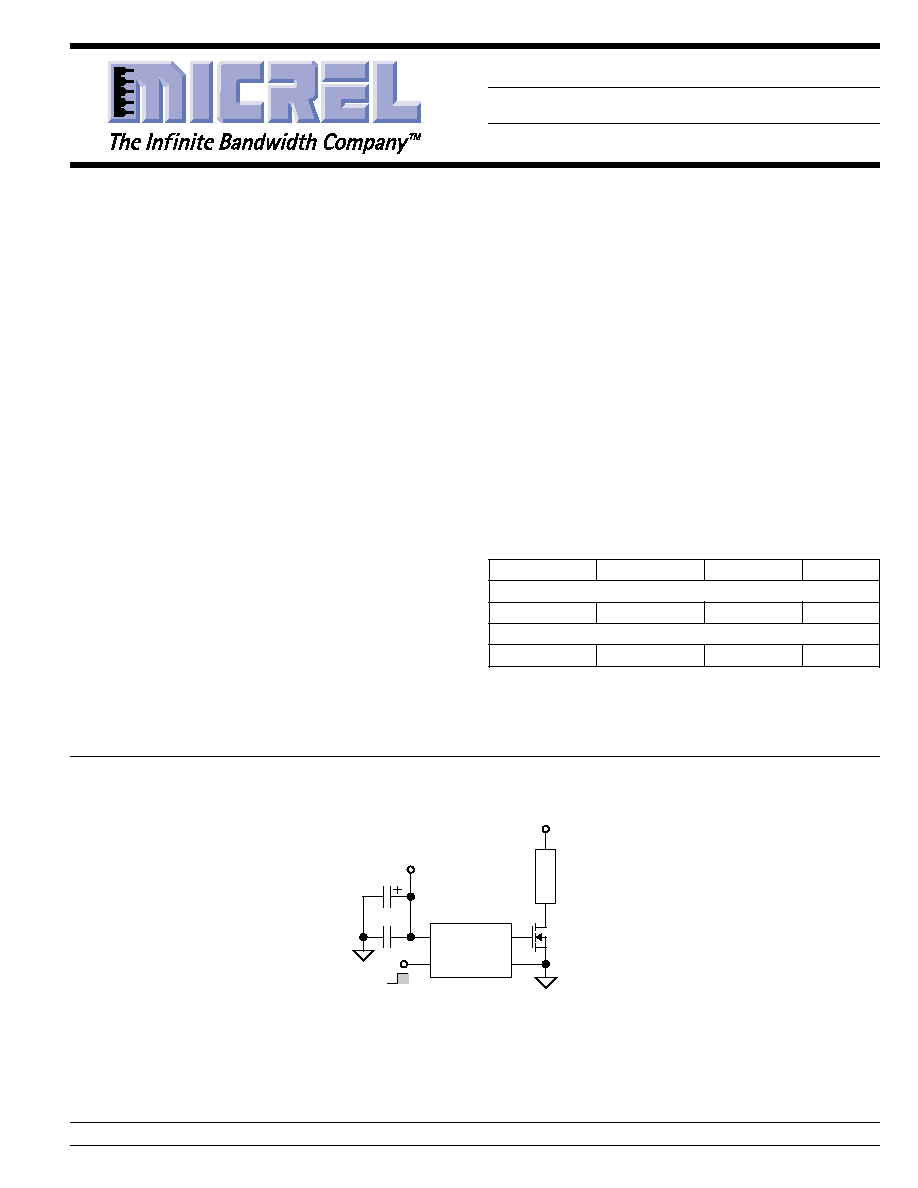
June 2001
1
MIC4416/4417
MIC4416/4417
Micrel
Features
∑ +4.5V to +18V operation
∑ Low steady-state supply current
50
µ
A typical, control input low
370
µ
A typical, control input high
∑ 1.2A nominal peak output
3.5
typical output resistance at 18V supply
7.8
typical output resistance at 5V supply
∑ 25mV maximum output offset from supply or ground
∑ Operates in low-side switch circuits
∑ TTL-compatible input withstands ≠20V
∑ ESD protection
∑ Inverting and noninverting versions
Applications
∑ Battery conservation
∑ Solenoid and motion control
∑ Lamp control
∑ Switch-mode power supplies
Ordering Information
Part Number
Temp. Range
Package
Marking
Noninverting
MIC4416BM4
≠40
∞
C to +85
∞
C
SOT-143
D10
Inverting
MIC4417BM4
≠40
∞
C to +85
∞
C
SOT-143
D11
MIC4416/4417
IttyBittyTM Low-Side MOSFET Driver
Final Information
General Description
The MIC4416 and MIC4417 IttyBittyTM low-side MOSFET
drivers are designed to switch an N-channel enhancement-
type MOSFET from a TTL-compatible control signal in low-
side switch applications. The MIC4416 is noninverting and
the MIC4417 is inverting. These drivers feature short delays
and high peak current to produce precise edges and rapid
rise and fall times. Their tiny 4-lead SOT-143 package uses
minimum space.
The MIC4416/7 is powered from a +4.5V to +18V supply
voltage. The on-state gate drive output voltage is approxi-
mately equal to the supply voltage (no internal regulators or
clamps). High supply voltages, such as 10V, are appropriate
for use with standard N-channel MOSFETs. Low supply
voltages, such as 5V, are appropriate for use with logic-level
N-channel MOSFETs.
In a low-side configuration, the driver can control a MOSFET
that switches any voltage up to the rating of the MOSFET.
The MIC4416 is available in the SOT-143 package and
is rated for ≠40
∞
C to +85
∞
C ambient temperature range.
Typical Application
On
Off
VS
CTL
G
GND
MIC4416
4.7µF
Si9410DY*
N-channel
MOSFET
Load
Voltage
1
3
2
4
Load
+12V
Load voltage limited only by
MOSFET drain-to-source rating
* Siliconix
30m
, 7A max.
0.1µF
Low-Side Power Switch
Micrel, Inc. ∑ 1849 Fortune Drive ∑ San Jose, CA 95131 ∑ USA ∑ tel + 1 (408) 944-0800 ∑ fax + 1 (408) 944-0970 ∑ http://www.micrel.com

MIC4416/4417
Micrel
MIC4416/4417
2
June 2001
Pin Configuration
GND
CTL
VS
G
Dxx
Part
Identification
1
2
3
4
SOT-143 (M4)
Pin Description
Pin Number
Pin Name
Pin Function
1
GND
Ground: Power return.
2
G
Gate (Output) : Gate connection to external MOSFET.
3
VS
Supply (Input): +4.5V to +18V supply.
4
CTL
Control (Input): TTL-compatible on/off control input.
MIC4416 only: Logic high forces the gate output to the supply voltage.
Logic low forces the gate output to ground.
MIC4417 only: Logic high forces the gate output to ground. Logic low
forces the gate output to the supply voltage.
Part Number
Identification
MIC4416BM4
D10
MIC4417BM4
D11
Early production identification: ML10

June 2001
3
MIC4416/4417
MIC4416/4417
Micrel
Electrical Characteristics
(Note 3)
Parameter
Condition (Note 1)
Min
Typ
Max
Units
Supply Current
4.5V
V
S
18V
V
CTL
= 0V
50
200
µ
A
V
CTL
= 5V
370
1500
µ
A
Control Input Voltage
4.5V
V
S
18V
V
CTL
for logic 0 input
0.8
V
V
CTL
for logic 1 input
2.4
V
Control Input Current
0V
V
CTL
V
S
≠10
10
µ
A
Delay Time, V
CTL
Rising
V
S
= 5V
C
L
= 1000pF, Note 2
42
ns
V
S
= 18V
C
L
= 1000pF, Note 2
33
60
ns
Delay Time, V
CTL
Falling
V
S
= 5V
C
L
= 1000pF, Note 2
42
ns
V
S
= 18V
C
L
= 1000pF, Note 2
23
40
ns
Output Rise Time
V
S
= 5V
C
L
= 1000pF, Note 2
24
ns
V
S
= 18V
C
L
= 1000pF, Note 2
14
40
ns
Output Fall Time
V
S
= 5V
C
L
= 1000pF, Note 2
28
ns
V
S
= 18V
C
L
= 1000pF, Note 2
16
40
ns
Gate Output Offset Voltage
4.5V
V
S
18V
V
G
= high
≠25
mV
V
G
= low
25
mV
Output Resistance
V
S
= 5V, I
OUT
= 10mA
P-channel (source) MOSFET
7.6
N-channel (sink) MOSFET
7.8
V
S
= 18V, I
OUT
= 10mA
P-channel (source) MOSFET
3.5
10
N-channel (sink) MOSFET
3.5
10
Gate Output Reverse Current
No latch up
250
mA
General Note: Devices are ESD protected, however handling precautions are recommended.
Note 1:
Typical values at T
A
= 25
∞
C. Minimum and maximum values indicate performance at ≠40
∞
C
T
A
+85
∞
C. Parts production tested at 25
∞
C.
Note 2:
Refer to "MIC4416 Timing Definitions" and "MIC4417 Timing Definitions" diagrams (see next page).
Note 3:
Specification for packaged product only.
Absolute Maximum Ratings
Supply Voltage (V
S
) .................................................... +20V
Control Voltage (V
CTL
) .................................. ≠20V to +20V
Gate Voltage (V
G
) ....................................................... +20V
Junction Temperature (T
J
) ........................................ 150
∞
C
Lead Temperature, Soldering ................... 260
∞
C for 5 sec.
Operating Ratings
Supply Voltage (V
S
) ....................................... +4.5 to +18V
Control Voltage (V
CTL
) .......................................... 0V to V
S
Ambient Temperature Range (T
A
) ............. ≠40
∞
C to +85
∞
C
Thermal Resistance
(
JA
) ...................................... 220
∞
C/W
(soldered to 0.25in
2
copper ground plane)

MIC4416/4417
Micrel
MIC4416/4417
4
June 2001
Definitions
VS
CTL
G
GND
MIC4416/7
V
SUPPLY
1
3
2
4
V
OUT
V
SUPPLY
Source State
(P-channel on, N-channel off)
I
OUT
I
SUPPLY
VS
CTL
G
GND
MIC4416/7
V
SUPPLY
1
3
2
4
V
OUT
GND
Sink State
(P-channel off, N-channel on)
I
OUT
I
SUPPLY
MIC4416 = high
MIC4417 = low
MIC4416 = low
MIC4417 = high
MIC4416/MIC4417 Operating States
90%
10%
rise
time
10%
0V
5V
fall
time
V
S
OUTPUT
INPUT
90%
0V
delay
time
delay
time
pulse
width
2.5V
MIC4416 (Noninverting) Timing Definitions
delay
time
90%
10%
rise
time
10%
0V
5V
delay
time
fall
time
V
S
OUTPUT
INPUT
90%
0V
2.5V
pulse
width
MIC4417 (Inverting) Timing Definitions
Test Circuit
5V
0V
VS
CTL
G
GND
MIC4416/7
V
SUPPLY
1
3
2
4
C
L
V
OUT
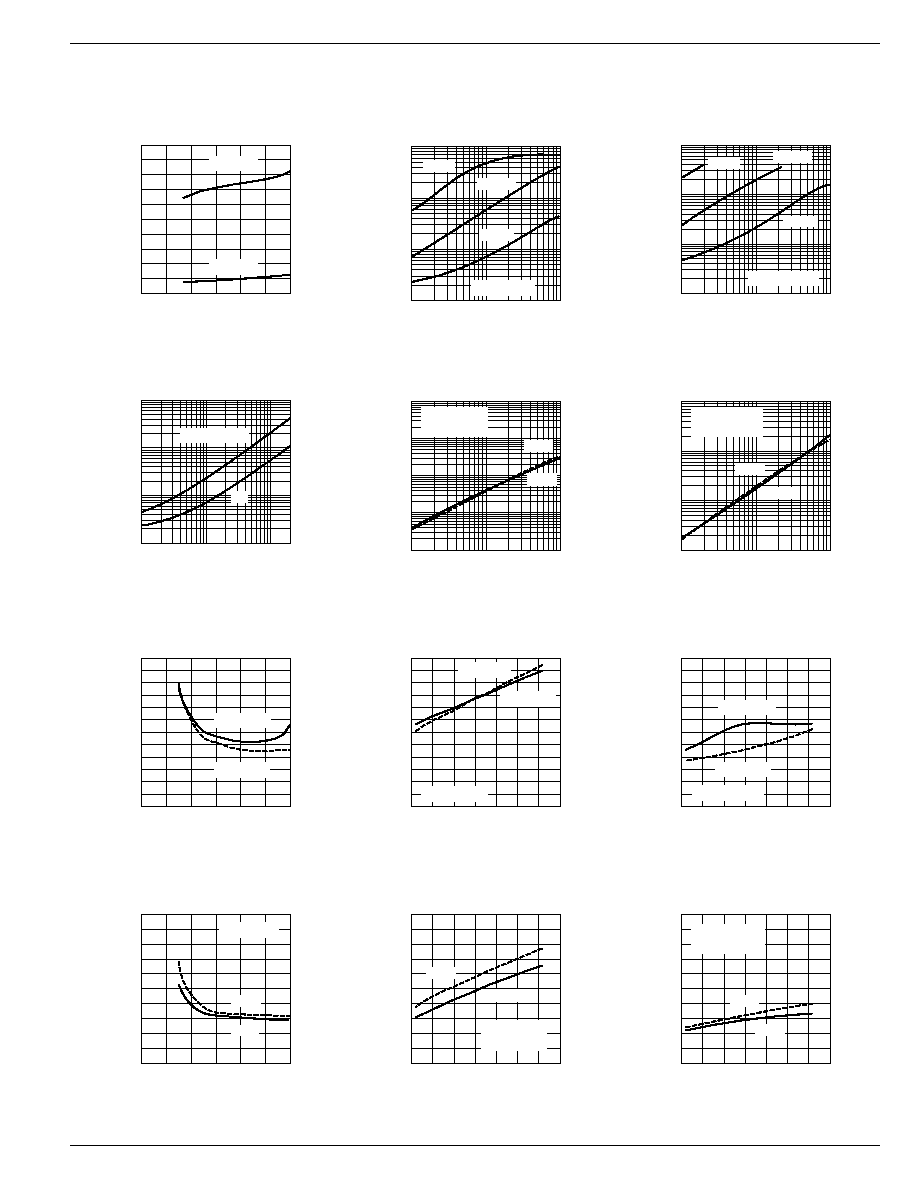
June 2001
5
MIC4416/4417
MIC4416/4417
Micrel
0
10
20
30
40
50
0
3
6
9
12
15
18
TIME (ns)
SUPPLY VOLTAGE (V)
Rise and Fall Time
vs. Supply Voltage
FALL
RISE
f
CTL
= 1MHz
0
10
20
30
40
50
-60 -30
0
30
60
90 120 150
TIME (ns)
TEMPERATURE (
∞
C)
Rise and Fall Time
vs. Temperature
RISE
V
SUPPLY
= 5V
f
CTL
= 1MHz
FALL
0
10
20
30
40
50
-60 -30
0
30
60
90 120 150
TIME (ns)
TEMPERATURE (
∞
C)
Rise and Fall Time
vs. Temperature
RISE
V
SUPPLY
= 18V
f
CTL
= 1MHz
FALL
Typical Characteristics
Note 3
0
100
200
300
400
500
0
3
6
9
12
15
18
SUPPLY CURRENT (
µ
A)
SUPPLY VOLTAGE (V)
Quiescent Supply Current
vs. Supply Voltage
V
CTL
= 5V
V
CTL
= 0V
0.1
1
10
100
1
10
100
SUPPLY CURRENT (mA)
CAPACITANCE (nF)
Supply Current
vs. Load Capacitance
V
SUPPLY
= 5V
100kHz
10kHz
1MHz
0.1
1
10
100
10
100
1000
2000
SUPPLY CURRENT (mA)
FREQUENCY (kHz)
Supply Current
vs. Frequency
V
SUPPLY
= 18V
5V
0.01
0.1
1
10
100
1
10
100
TIME (
µ
s)
CAPACITANCE (nF)
Output Rise and Fall Time
vs. Load Capacitance
FALL
RISE
V
SUPPLY
= 5V
f
CTL
= 50kHz
0
10
20
30
40
50
60
0
3
6
9
12
15
18
TIME (ns)
SUPPLY VOLTAGE (V)
Delay Time
vs. Supply Voltage
V
CTL
RISE
V
CTL
FALL
0
10
20
30
40
50
60
-60 -30
0
30
60
90 120 150
TIME (ns)
TEMPERATURE (
∞
C)
Delay Time
vs. Temperature
V
SUPPLY
= 5V
V
CTL
RISE
V
CTL
FALL
0
10
20
30
40
50
60
-60 -30
0
30
60
90 120 150
TIME (ns)
TEMPERATURE (
∞
C)
Delay Time
vs. Temperature
V
SUPPLY
= 18V
V
CTL
RISE
V
CTL
FALL
0.1
1
10
100
1
10
100
SUPPLY CURRENT (mA)
CAPACITANCE (nF)
Supply Current
vs. Load Capacitance
V
SUPPLY
= 18V
100kHz
10kHz
1MHz
0.01
0.1
1
10
1
10
100
TIME (
µ
s)
CAPACITANCE (nF)
Output Rise and Fall Time
vs. Load Capacitance
FALL
RISE
V
SUPPLY
= 18V
f
CTL
= 50kHz
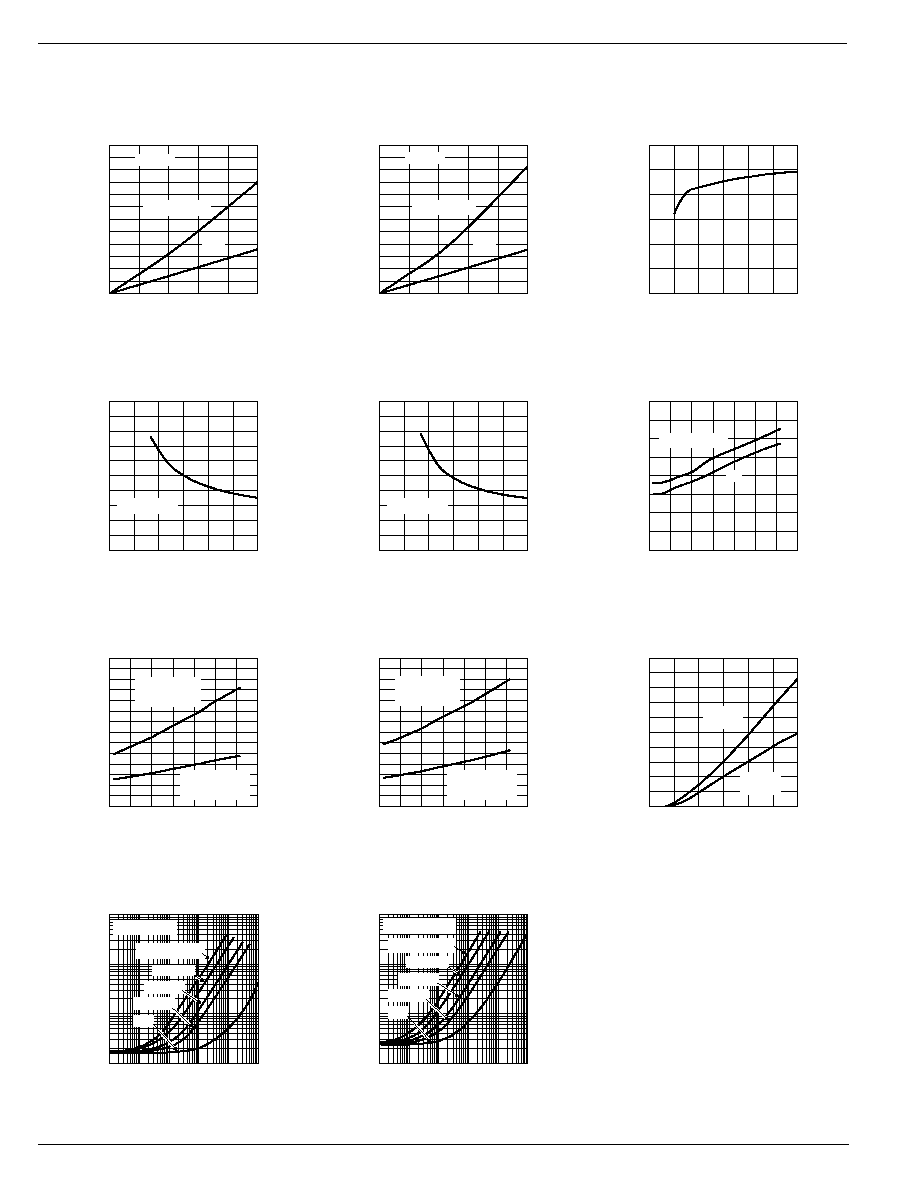
MIC4416/4417
Micrel
MIC4416/4417
6
June 2001
0
200
400
600
800
1000
1200
0
20
40
60
80
100
VOLTAGE DROP (mV)
OUTPUT CURRENT (mA)
Output Voltage Drop vs.
Output Source Current
V
SUPPLY
= 5V
18V
NOTE 4
0
200
400
600
800
1000
1200
0
20
40
60
80
100
VOLTAGE DROP (mV)
OUTPUT CURRENT (mA)
Output Voltage Drop vs.
Output Sink Current
V
SUPPLY
= 5V
18V
NOTE 5
0
100
200
300
400
500
600
0
3
6
9
12
15
18
HYSTERESIS (mV)
SUPPLY VOLTAGE (V)
Control Input Hysteresis
vs. Supply Voltage
0
2
4
6
8
10
0
3
6
9
12
15
18
ON RESISTANCE (
)
SUPPLY VOLTAGE (V)
Output
Source Resistance
I
OUT
= 10mA
0
200
400
600
800
-60 -30
0
30
60
90 120 150
HYSTERESIS (mV)
TEMPERATURE (
∞
C)
Control Input Hysteresis
vs. Temperature
V
SUPPLY
= 18V
5V
0
2
4
6
8
10
12
14
-60 -30
0
30
60
90 120 150
ON-RESISTANCE (
)
TEMPERATURE (
∞
C)
Output Source Resistance
vs. Temperature
V
SUPPLY
= 5V
I
OUT
3mA
V
SUPPLY
= 18V
I
OUT
3mA
0
2
4
6
8
10
0
3
6
9
12
15
18
ON RESISTANCE (
)
SUPPLY VOLTAGE (V)
Output
Sink Resistance
I
OUT
= 10mA
0
2
4
6
8
10
12
14
-60 -30
0
30
60
90 120 150
ON-RESISTANCE (
)
TEMPERATURE (
∞
C)
Output Sink Resistance
vs. Temperature
V
SUPPLY
= 5V
I
OUT
3mA
V
SUPPLY
= 18V
I
OUT
3mA
0
0.5
1.0
1.5
2.0
2.5
0
3
6
9
12
15
18
CURRENT (A)
SUPPLY VOLTAGE (V)
Peak Output Current
vs. Supply Voltage
Sink
NOTE 7
Source
NOTE 6
0.1
1
10
100
1x10
2
1x10
3
1x10
4
1x10
5
1x10
6
1x10
7
SUPPLY CURRENT (mA)
FREQUENCY (Hz)
Supply Current
vs. Frequency
0pF
1,000pF
2,000pF
5,000pF
C
L
= 10,000pF
V
SUPPLY
= 5V
0.1
1
10
100
1x10
2
1x10
3
1x10
4
1x10
5
1x10
6
1x10
7
SUPPLY CURRENT (mA)
FREQUENCY (Hz)
Supply Current
vs. Frequency
0pF
1,000pF
2,000pF
5,000pF
C
L
= 10,000pF
V
SUPPLY
= 18V
Note 3:
Typical Characteristics at
T
A
= 25
∞
C, V
S
= 5V,
C
L
= 1000pF unless noted.
Note 4:
Source-to-drain voltage drop across the
internal P-channel MOSFET =
V
S
≠ V
G
.
Note 5:
Drain-to-source voltage drop across the
internal N-channel MOSFET = V
G
≠ V
GND
.
(Voltage applied to G.)
Note 6:
1
µ
s pulse test, 50% duty cycle. OUT
connected to GND. OUT sources current.
(MIC4416, V
CTL
= 5V;
MIC4417, V
CTL
= 0V)
Note 7:
1
µ
s pulse test, 50% duty cycle. VS
connected to OUT. OUT sinks current.
(MIC4416, V
CTL
= 0V;
MIC4417, V
CTL
= 5V)
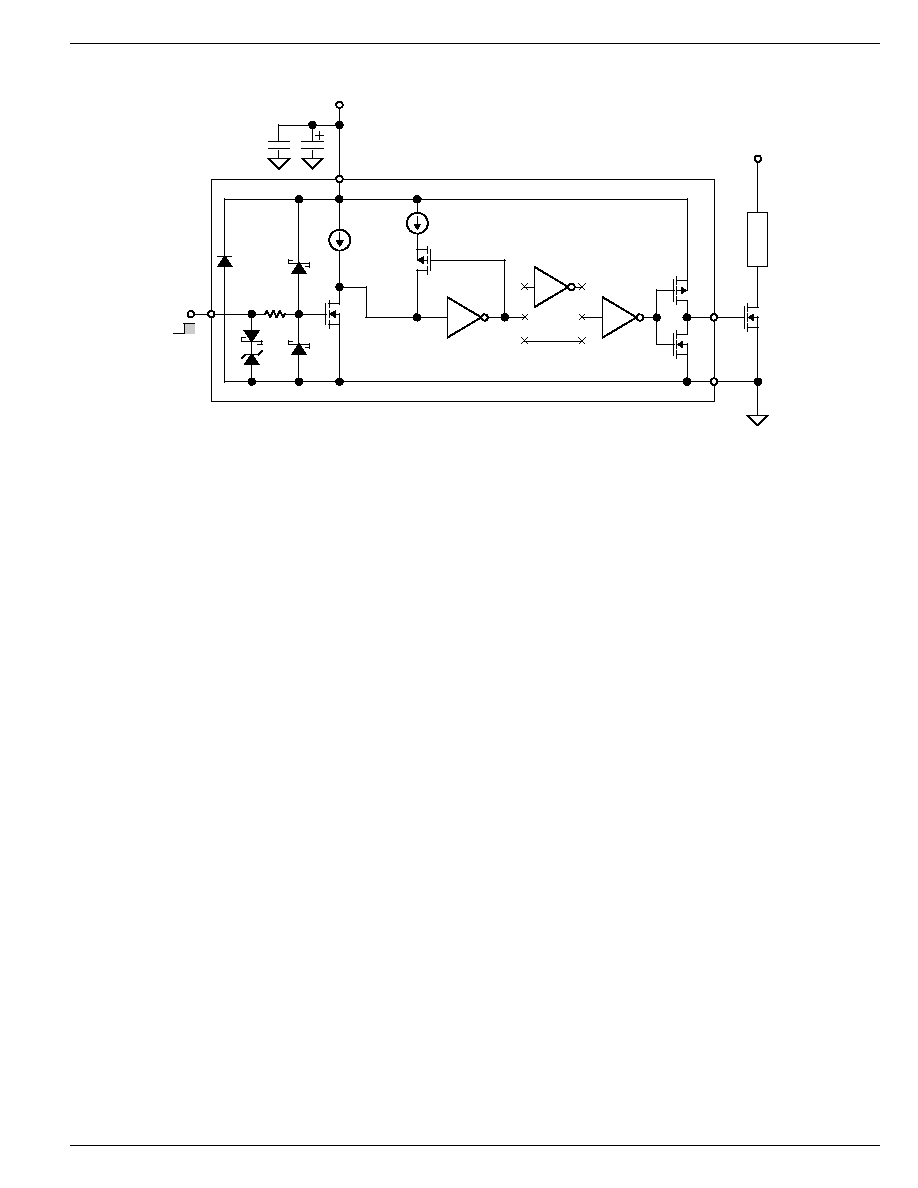
June 2001
7
MIC4416/4417
MIC4416/4417
Micrel
Functional Description
Refer to the functional diagram.
The MIC4416 is a noninverting driver. A logic high on the CTL
(control) input produces gate drive output. The MIC4417 is
an inverting driver. A logic low on the CTL (control) input
produces gate drive output. The G (gate) output is used to
turn on an external N-channel MOSFET.
Supply
VS (supply) is rated for +4.5V to +18V. External capacitors
are recommended to decouple noise.
Control
CTL (control) is a TTL-compatible input. CTL must be forced
high or low by an external signal. A floating input will cause
unpredictable operation.
A high input turns on Q1, which sinks the output of the 0.3mA
and the 0.6mA current source, forcing the input of the first
inverter low.
Hysteresis
The control threshold voltage, when CTL is rising, is slightly
higher than the control threshold voltage when CTL is falling.
When CTL is low, Q2 is on, which applies the additional
0.6mA current source to Q1. Forcing CTL high turns on Q1
which must sink 0.9mA from the two current sources. The
higher current through Q1 causes a larger drain-to-source
voltage drop across Q1. A slightly higher control voltage is
required to pull the input of the first inverter down to its
threshold.
Functional Diagram
Logic-Level
Input
VS
CTL
G
MIC4417
INVERTING
MIC4416
NONINVERTING
0.3mA
0.6mA
R1
2k
GND
Load
V
SWITCHED
V
SUPPLY
D1
D4
D2
D5
D3
35V
Q1
Q2
Q3
Q4
Functional Diagram with External Components
Q2 turns off after the first inverter output goes high. This
reduces the current through Q1 to 0.3mA. The lower current
reduces the drain-to-source voltage drop across Q1. A
slightly lower control voltage will pull the input of the first
inverter up to its threshold.
Drivers
The second (optional) inverter permits the driver to be manu-
factured in inverting and noninverting versions.
The last inverter functions as a driver for the output MOSFETs
Q3 and Q4.
Gate Output
G (gate) is designed to drive a capacitive load. V
G
(gate
output voltage) is either approximately the supply voltage or
approximately ground, depending on the logic state applied
to CTL.
If CTL is high, and VS (supply) drops to zero, the gate output
will be floating (unpredictable).
ESD Protection
D1 protects VS from negative ESD voltages. D2 and D3
clamp positive and negative ESD voltages applied to CTL.
R1 isolates the gate of Q1 from sudden changes on the CTL
input. D4 and D5 prevent Q1's gate voltage from exceeding
the supply voltage or going below ground.
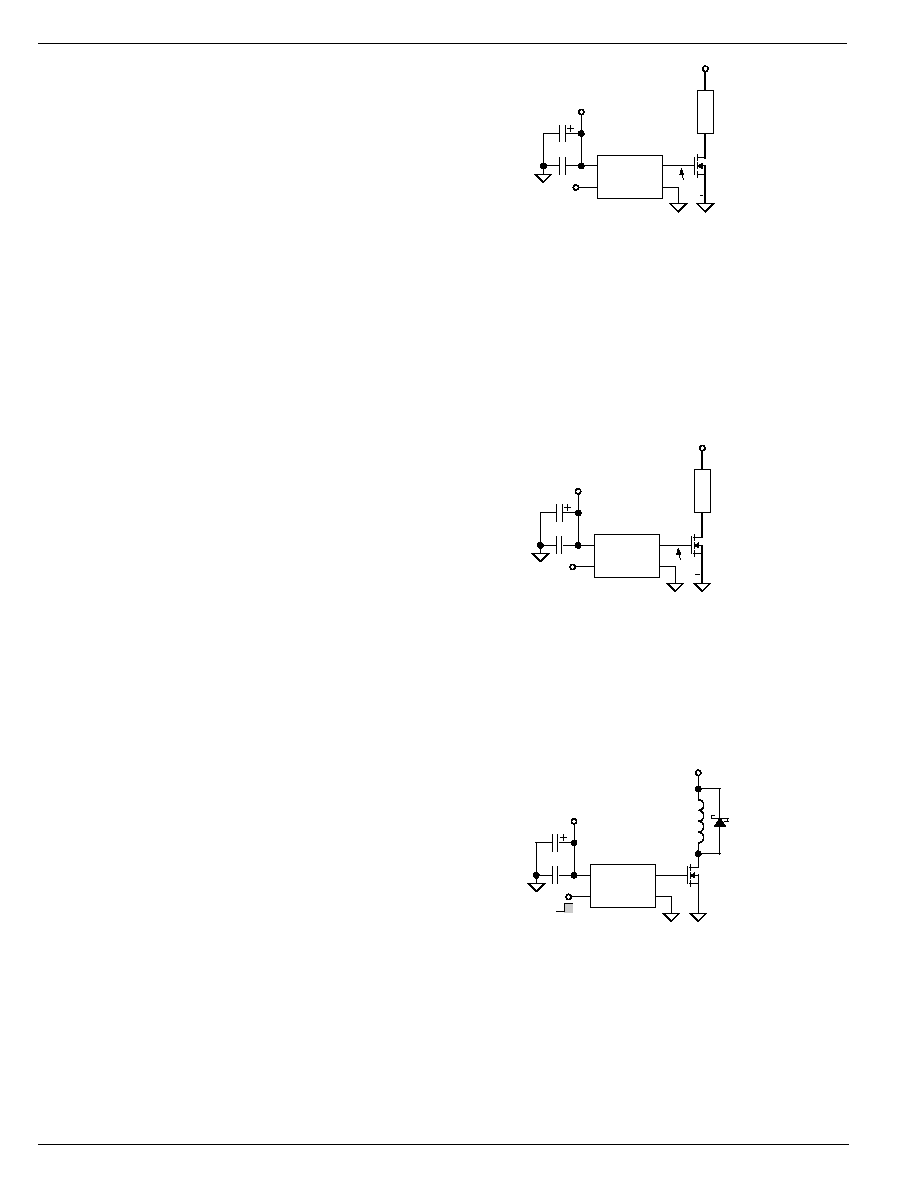
MIC4416/4417
Micrel
MIC4416/4417
8
June 2001
Application Information
The MIC4416/7 is designed to provide high peak current for
charging and discharging capacitive loads. The 1.2A peak
value is a nominal value determined under specific condi-
tions. This nominal value is used to compare its relative size
to other low-side MOSFET drivers. The MIC4416/7 is not
designed to directly switch 1.2A continuous loads.
Supply Bypass
Capacitors from VS to GND are recommended to control
switching and supply transients. Load current and supply
lead length are some of the factors that affect capacitor
size requirements.
A 4.7
µ
F or 10
µ
F tantalum capacitor is suitable for many
applications. Low-ESR (equivalent series resistance) metal-
ized film capacitors may also be suitable. An additional 0.1
µ
F
ceramic capacitor is suggested in parallel with the larger
capacitor to control high-frequency transients.
The low ESR (equivalent series resistance) of tantalum
capacitors makes them especially effective, but also makes
them susceptible to uncontrolled inrush current from low
impedance voltage sources (such as NiCd batteries or auto-
matic test equipment). Avoid instantaneously applying volt-
age, capable of very high peak current, directly to or near
tantalum capacitors without additional current limiting. Nor-
mal power supply turn-on (slow rise time) or printed circuit
trace resistance is usually adequate for normal product
usage.
Circuit Layout
Avoid long power supply and ground traces. They exhibit
inductance that can cause voltage transients (inductive kick).
Even with resistive loads, inductive transients can sometimes
exceed the ratings of the MOSFET and the driver.
When a load is switched off, supply lead inductance forces
current to continue flowing--resulting in a positive voltage
spike. Inductance in the ground (return) lead to the supply
has similar effects, except the voltage spike is negative.
Switching transitions momentarily draw current from VS to
GND. This combines with supply lead inductance to create
voltage transients at turn on and turnoff.
Transients can also result in slower apparent rise or fall times
when driver's ground shifts with respect to the control input.
Minimize the length of supply and ground traces or use
ground and power planes when possible. Bypass capacitors
should be placed as close as practical to the driver.
MOSFET Selection
Standard MOSFET
A standard N-channel power MOSFET is fully enhanced with
a gate-to-source voltage of approximately 10V and has an
absolute maximum gate-to-source voltage of
±
20V.
The MIC4416/7's on-state output is approximately equal to
the supply voltage. The lowest usable voltage depends upon
the behavior of the MOSFET.
VS
CTL
G
GND
MIC4416
4.7µF
+8V to +18V
1
3
2
4
Load
Logic
Input
* Gate enhancement voltage
V
GS
*
+15V
Standard
MOSFET
IRFZ24
International Rectifier
100m
, 60V MOSFET
0.1µF
Try a
15
, 15W
or
1k, 1/4W
resistor
Figure 1. Using a Standard MOSFET
Logic-Level MOSFET
Logic-level N-channel power MOSFETs are fully enhanced
with a gate-to-source voltage of approximately 5V and have
an absolute maximum gate-to-source voltage of
±
10V. They
are less common and generally more expensive.
The MIC4416/7 can drive a logic-level MOSFET if the supply
voltage, including transients, does not exceed the maximum
MOSFET gate-to-source rating (10V).
VS
CTL
G
GND
MIC4416
+4.5V to 10V*
1
3
2
4
Load
Logic
Input
* Gate enhancement voltage
(must not exceed 10V)
V
GS
*
+5V
Logic-Level
MOSFET
IRLZ44
International Rectifier
28m
, 60V MOSFET
4.7µF
0.1µF
Try a
3
, 10W
or
100
, 1/4W
resistor
Figure 2. Using a Logic-Level MOSFET
At low voltages, the MIC4416/7's internal P- and N-channel
MOSFET's on-resistance will increase and slow the output
rise time. Refer to "Typical Characteristics" graphs.
Inductive Loads
On
Off
VS
CTL
G
GND
MIC4416
V
SUPPLY
1
3
2
4
Schottky
Diode
V
SWITCHED
4.7µF
0.1µF
Figure 3. Switching an Inductive Load
Switching off an inductive load in a low-side application forces
the MOSFET drain higher than the supply voltage (as the
inductor resists changes to current). To prevent exceeding
the MOSFET's drain-to-gate and drain-to-source ratings, a
Schottky diode should be connected across the inductive
load.
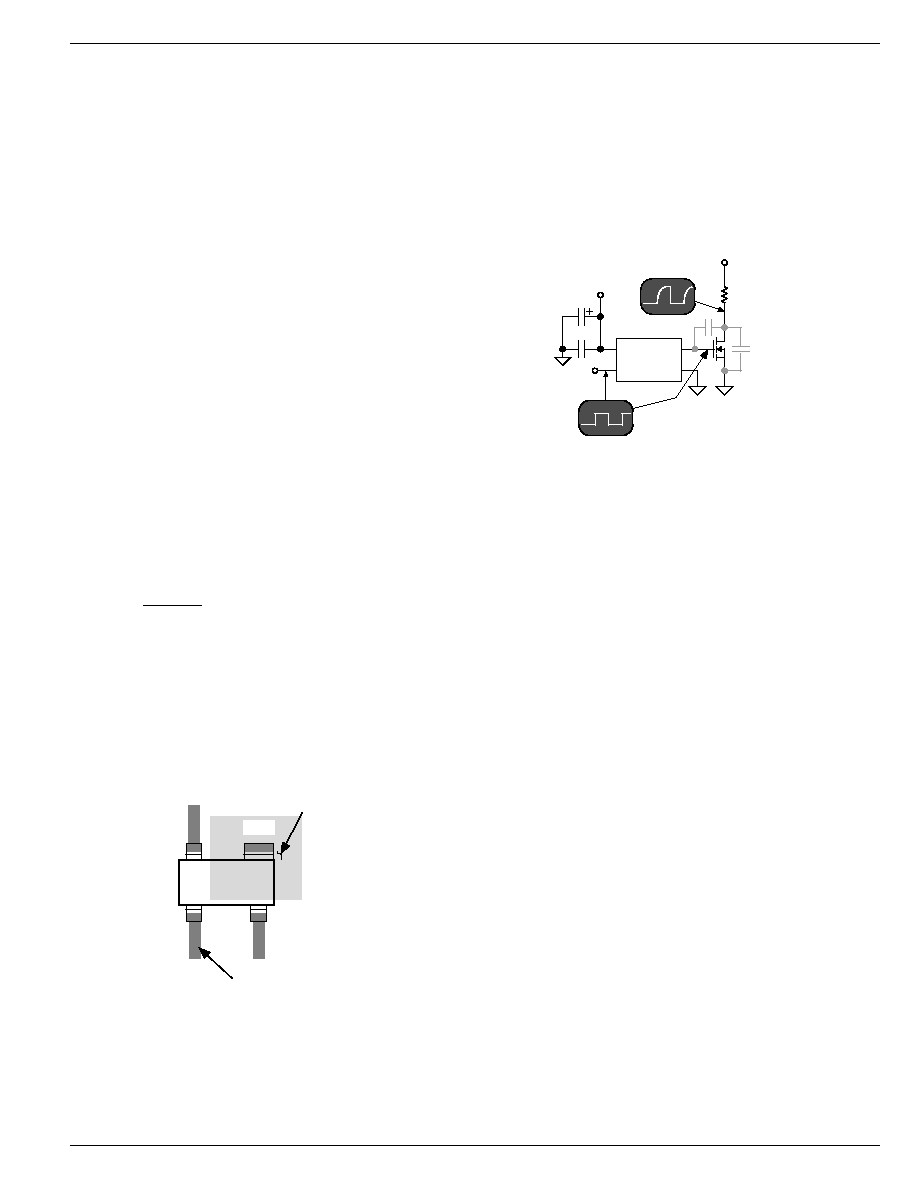
June 2001
9
MIC4416/4417
MIC4416/4417
Micrel
Power Dissipation
The maximum power dissipation must not be exceeded to
prevent die meltdown or deterioration.
Power dissipation in on/off switch applications is negligible.
Fast repetitive switching applications, such as SMPS (switch-
mode power supplies), cause a significant increase in power
dissipation with frequency. Power is dissipated each time
current passes through the internal output MOSFETs when
charging or discharging the external MOSFET. Power is also
dissipated during each transition when some current momen-
tarily passes from VS to GND through both internal MOSFETs.
Power dissipation is the product of supply voltage and supply
current:
1)
P
D
= V
S
◊
I
S
where:
P
D
= power dissipation (W)
V
S
= supply voltage (V)
I
S
= supply current (A) [see paragraph below]
Supply current is a function of supply voltage, switching
frequency, and load capacitance. Determine this value from
the "Typical Characteristics: Supply Current vs. Frequency"
graph or measure it in the actual application.
Do not allow P
D
to exceed P
D (max)
, below.
T
J
(junction temperature) is the sum of T
A
(ambient tempera-
ture) and the temperature rise across the thermal resistance
of the package. In another form:
2)
P
150
T
220
D
A
-
where:
P
D (max)
= maximum power dissipation (W)
150 = absolute maximum junction temperature (
∞
C)
T
A
= ambient temperature (
∞
C) [68
∞
F = 20
∞
C]
220 = package thermal resistance (
∞
C/W)
Maximum power dissipation at 20
∞
C with the driver soldered
to a 0.25in
2
ground plane is approximately 600mW.
CTL
G
VS
GND
PCB heat sink/
ground plane
PCB traces
Figure 4. Heat-Sink Plane
The SOT-143 package
JA
(junction-to-ambient thermal re-
sistance) can be improved by using a heat sink larger than the
specified 0.25in
2
ground plane. Significant heat transfer
occurs through the large (GND) lead. This lead is an
extension of the paddle to which the die is attached.
High-Frequency Operation
Although the MIC4416/7 driver will operate at frequencies
greater than 1MHz, the MOSFET's capacitance and the load
will affect the output waveform (at the MOSFET's drain).
For example, an MIC4416/IRL3103 test circuit using a 47
5W load resistor will produce an output waveform that closely
matches the input signal shape up to about 500kHz. The
same test circuit with a 1k
load resistor operates only up to
about 25kHz before the MOSFET source waveform shows
significant change.
VS
CTL
G
GND
MIC4416
+4.5V to 18V
1
3
2
4
Logic
Input
+5V
Logic-Level
MOSFET
IRL3103*
* International Rectifier
14m
, 30V MOSFET,
logic-level, V
GS
=
±
20V max.
4.7µF
0.1µF
Compare
47k
, 5W
to
1k
, 1/4W
loads
G
D
S
Slower rise time
observed at
MOSFET's drain
Figure 5. MOSFET Capacitance Effects at High
Switching Frequency
When the MOSFET is driven off, the slower rise occurs
because the MOSFET's output capacitance recharges through
the load resistance (RC circuit). A lower load resistance
allows the output to rise faster. For the fastest driver opera-
tion, choose the smallest power MOSFET that will safely
handle the desired voltage, current, and safety margin. The
smallest MOSFETs generally have the lowest capacitance.

MIC4416/4417
Micrel
MIC4416/4417
10
June 2001
Package Information
0.150 (0.0059)
0.089 (0.0035)
8
∞
0
∞
0.400 (0.016) TYP 3 PLACES
2.50 (0.098)
2.10 (0.083)
1.40 (0.055)
1.20 (0.047)
0.950 (0.0374) TYP
3.05 (0.120)
2.67 (0.105)
0.800 (0.031) TYP
1.12 (0.044)
0.81 (0.032)
0.10 (0.004)
0.013 (0.0005)
DIMENSIONS:
MM (INCH)
0.41 (0.016)
0.13 (0.005)
CL
CL
4-Pin SOT-143 (M4)
MICREL INC.
1849 FORTUNE DRIVE
SAN JOSE, CA 95131
USA
TEL
+ 1 (408) 944-0800
FAX
+ 1 (408) 944-0970
WEB
http://www.micrel.com
This information is believed to be accurate and reliable, however no responsibility is assumed by Micrel for its use nor for any infringement of patents or
other rights of third parties resulting from its use. No license is granted by implication or otherwise under any patent or patent right of Micrel Inc.
© 2001 Micrel Incorporated









